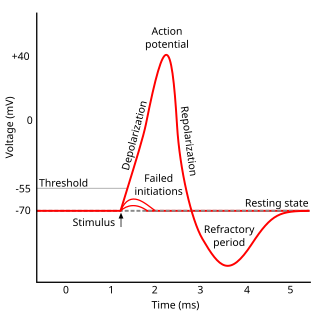Nerve impulse
process by which neurons communicate with each other by changes in their membrane potentials. From Wikipedia, the free encyclopedia
A nerve impulse are the series of electrical signals that is generated in the neurons (nerve cells) in a response to stimulus.[1]


Mechanism of Conduction
Polarisation
When a neuron is not conducting or is in a resting state, the axonal membrane is more permeable to K+ ions and impermeable to Na+ ions. The sodium-potassium pump actively pumps out 3Na+ ions to the extracellular fluid and takes in 2K+ ions into the cell. Due to the imbalance in charge, a potential difference is developed across the axonal membrane, also known as the resting potential (-70mV). The outer side of the membrane will have a positive charge while the inner side will have a negative charge.[2]

Depolarisation
When a stimulus (chemical, mechanical or electrical) is applied to the membrane, the sodium-potassium pump stops working. The Na+ ions will rush inside the cell followed by the reversal of polarity of the axonal membrane. It is also called depolarisation of the nerve fibre. The electric potential difference at the site of stimulus is called the action potential (+40mV).[2]
Repolarisation
As a result, the current will flow from depolarised part of nerve fibre to polarised part of the nerve fibre in the axoplasm, while current flows in the opposite direction on the cell surface. Thus, in this way, a new action potential is generated up ahead in the nerve fibre. The time taken by the axonal membrane to get polarised again is called the refractory period (1ms). After the refractory period, the sodium-potassium pump will operate again and the membrane will return to its resting state again.[2]
Special faster connections
Faster electrical synapses are used in escape reflexes, the retina of vertebrates, and the heart. They are faster because they do not need the slow diffusion of neurotransmitters across the synaptic gap. Therefore, electrical synapses are used whenever fast response and coordination of timing are crucial.
These synapses connect the presynaptic and postsynaptic cells directly together.[3] When an action potential reaches such a synapse, the ionic currents cross the two cell membranes and enter the postsynaptic cell through pores known as connexons.[4] Thus, presynaptic action potential directly stimulates the postsynaptic cell.
References
Other websites
Wikiwand - on
Seamless Wikipedia browsing. On steroids.
